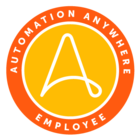Objective: Following a tutorial to build a bot is one thing - but it's important as a new bot developer to understand the Control Room, how the development interface is laid out, and the flow that bots typically follow from ideation to public check-in and deployment.
The Control Room is the central interface for all things bot management, global value creation, user management, deployment, and testing. All that said, depending on your role within the organization - you may or may not see all of those capabilities from the Automation 360 Control Room interface. While most of your time as a bot builder will be spent in the Bot Editor interface, it's important to recognize what else can be done from the Control Room itself. Take a look at the tabs you most likely have access to as a developer (again, if you don't see all of these tabs in your interface, it’s ok - that’s controlled through your role…it’s most important just to understand what’s possible from this interface at this point):
-
Activity: From the Activity tab users can see in-progress bot runs, set up and modify schedules for unattended bot runs, view event trigger details for bots that execute from a trigger, as well as view historical details on bots that have previously executed. Should you be executing unattended bot runner tests or reviewing production deployments - this will be the tab where you spend quite a bit of time.
-
Bots: From the Bots tab (where bot builders spend a majority of their time) - we can access our private bot repository as well as view bots and bot components that have been checked in to the public bot repository. Additionally, users have the capability to manage credentials (values that are securely stored in the Control Room for use by bots), manage global values (environment specific values which are accessible to all bots), as well as the packages section where developers have the ability to manage and install custom packages.
-
Devices: The Devices tab is where users come to set up devices which can be made available during development, testing, and production bot execution. It’s on this tab that users can add or remove devices, upgrade devices, and validate that the Bot Agent on a particular device is able to successfully connect to the Control Room.
-
Workload: Workload management in Automation 360 provides users with the capability of managing bot workload by dividing work into logical segments which can be processed simultaneously across bot runners. The Workload tab of the Control Room allows administrators and developers to setup, manage, and modify workload queues that have been set up for groups of bot runners - including adding and removing devices to different workload pools.
-
Bot Store: The Bot Store tab allows users to directly install free or paid content from the Automation Anywhere Bot Store directly into their Control Room. With this capability, pre-developed bots and custom packages that are acquired via Bot Store can be instantly installed and used in your own environment to accelerate the bot building process.
Let’s dive a bit deeper into a few of these topics by reviewing some of the materials below.
To Do
Take a look at the Automation 360 Control Room overview from the documentation portal.
Without getting too hung up on the technical architecture of the Control Room architecture, know that the Control Room is the centralized location for bot deployment, establishing and editing access control to bots and the Control Room, as well as the central hub for digital workforce management.
Get started with the Automation 360 Bot Editor
As mentioned, the Bot Editor is where bot builders will find themselves spending a majority of their time. Watch the following video on How to Get Started with the Bot Editor in Automation 360.
-
Its also worth taking a quick look at the Distributed Architecture of Automation Anywhere. Even if all the phrases don’t make sense right now, summarize it to say that the Control Room is the connection between those who are creating bots, those who are scheduling and managing bots, as well as Bot Runners which ultimately run the automations/bots.
Explore the Options for Expanding the Capabilities of your Control Room
-
The Automation 360 Control Room features Bot Store integration to easily install pre-built bots and custom packages into your environment directly in the Control Room interface itself.
-
Take a look at this video demonstrating how to Download a Bot Store Package into Your Automation 360 Control Room
-
Great developers know the best way to get things done is to appropriately leverage all the tools they have at their disposal. Take a look at Bot Store to learn about bots and packages that can help accelerate your bot building process and make a habit of exploring Bot Store capabilities as you start building new bots.
-
Summary
In order to successfully build, test, and manage bots, it’s important to understand the tool you’re using, its capabilities, and its features. As you creatively approach automation opportunities within your organization, be thinking back to the capabilities of Automation 360 and how you might leverage different bot capabilities and different product features to automate everything from simple tasks that need to run once a week to complex automations that leverage Bot Store custom packages and Workload management capabilities.
Resources
Videos
Optimize your Bot Building Interface
How to Download a Bot Store Bot into your Automation 360 Control Room
Communicating Between Bot Runners and Control Room Without Human Intervention
Blog Posts
There’s a Bot for That
Bot Store Bots for Re-usability and Faster Automation

